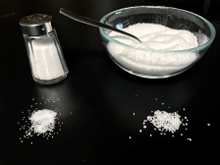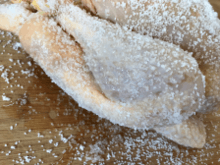Kosher salt

Kosher salt or kitchen salt[1] is coarse edible salt without common additives such as iodine. Used in cooking and not at the table, it consists mainly of sodium chloride and may include anticaking agents.
Usage
General cooking
Because the salt has a more pure flavor due to the lack of metallic or bitter tasting additives such as iodine, fluoride or dextrose, it is often used in the kitchen instead of additive-containing table salt so such flavors are not introduced to prepared food. Estimating the amount of salt can also be more easily gauged when salting by hand due to the larger grain size.[2] Some recipes specifically call for volume measurement of Kosher/kitchen salt which weighs less per measure due to its lower density, and is therefore less salty than an equal volume measurement of table salt.[3]
Brining meats

The coarse-grained salt is used to create a dry brine which increases succulence and flavor, sometimes with flavor additions such as herbs, spices or sugar[4]. The meat is typically soaked in cool water, drained, completely covered with a thin layer of salt, and then allowed to stand on a rack or board for an hour or more. The larger salt granules remain on the surface of the meat, for the most part undissolved, and absorb fluids from the meat which are then partially reabsorbed with the salt and any added flavors essentially brining the meat in its own juices. The salt rub is then rinsed off and discarded before cooking.[5][4]
Cleaning
Due to its grain size the salt is also used as an abrasive cleaner for cookware such as cast iron skillets. Mixed with oil it retains its abrasiveness but can be easily dissolved with water after cleaning, unlike pumice or calcium carbonate based cleansers which can leave a gritty residue if not thoroughly rinsed away.[6]
Name
The term Kosher salt gained common usage in North America and refers to its use in the Jewish religious practice of shechita (aka koshering / kashering) as opposed to the salt itself being manufactured in accordance with religious guidelines. Some brands further identify "kosher certified salt" as being certified by a religious body.[7]
Coarse edible salt is also known as cooking salt, flake salt, rock salt, koshering salt, and kashering salt in various cultures and countries world-wide.

Manufacturing
Rather than cubic crystals, kosher salt has a flat plate-like shape and may also have a hollow pyramidal shape. The flat form is usually made when cubic crystals are forced into this shape under pressure, usually between rollers. The pyramidal salt crystals are generally made by an evaporative process called the Alberger process. This salt is usually manufactured with a grain size larger than table salt grains.[8]
See also
References
| Wikimedia Commons has media related to Kosher salt. |
- ↑ "Kitchen salt definition". Collins. 2018.
- ↑ Nosrat, Samin (April 25, 2017). "The Single Most Important Ingredient". The New York Times. Retrieved 2018-04-07.
- ↑ Kaiser, Emily (February 25, 2004). "Chefs Who Salt Early if Not Often". The New York Times. Retrieved 2018-04-08.
- 1 2 Benwick, Bonnie S. (November 14, 2007). "Wet Brining vs. Dry: Give That Bird a Bath". The Washington Post. Retrieved 2018-04-07.
- ↑ Luban, Yaakov (2010). "Orthodox Union Kosher Primer". Orthodox Union.
- ↑ Lewis, Hunter (January 23, 2012). "How to Clean Your Cast-Iron Skillet". Bon Appetit. Retrieved 2018-04-08.
- ↑ "Kosher Salt Guide". SaltWorks. 2010.
- ↑ "Kosher Salt" (PDF). Salt Institute.